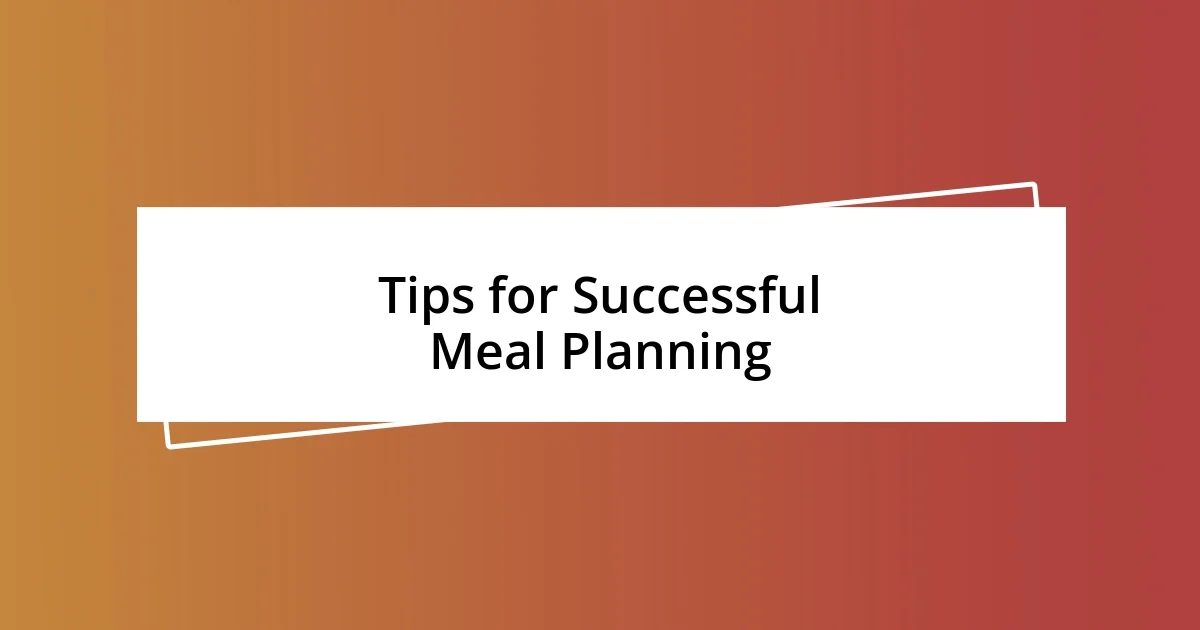Key takeaways:
- Identifying personal dietary needs through food diaries and understanding medical conditions is essential for effective meal planning.
- Setting clear meal planning goals, such as nutritional balance and mindful eating, transforms the process into a creative and purposeful endeavor.
- Organizing a weekly meal schedule with flexibility and proper food storage solutions enhances the overall meal prep experience and maintains healthy eating habits.

Understanding Special Diets Basics
Understanding the basics of special diets is essential for anyone navigating food restrictions, whether for health, ethical, or lifestyle reasons. I remember when I first learned about gluten intolerance; it felt overwhelming. There are so many labels and food items to consider, and it prompts a frantic question: how do you know what’s truly safe to eat?
Special diets often revolve around specific needs, such as vegetarianism, veganism, or food allergies. These diets can bring physical benefits, but they may also spark emotional challenges. I recall feeling left out at gatherings when everyone enjoyed traditional dishes. It made me wonder: how can one truly enjoy food when it feels limiting?
Moreover, understanding your body’s response to certain foods can be transformative. For instance, when I eliminated dairy, I noticed a significant change in my energy levels. Isn’t it fascinating how something as simple as diet can have such a profound impact on our well-being? Each person’s journey with food is unique, and recognizing that will help you tailor your meal planning successfully.

Identifying Personal Dietary Needs
Identifying personal dietary needs is the first step in crafting a meal plan that works for you. I’ve found that keeping a food diary significantly helped me understand my body’s responses to different foods. By jotting down what I ate and how I felt, I could pinpoint foods that triggered discomfort or fatigue. It’s a simple yet revealing exercise that can do wonders for your awareness.
It’s also important to consider any medical conditions or allergies when assessing dietary needs. For instance, when I was diagnosed with lactose intolerance, it was a wake-up call. I had to let go of some favorite foods, but it led me to explore delicious dairy-free alternatives. The first time I tried coconut yogurt, I was pleasantly surprised! It’s experiences like these that show how restrictions can often lead to discovering new favorites.
Lastly, emotional wellbeing plays a pivotal role in how we approach food. I remember a time when stress eating crept into my habits, leading to a realization that food was filling an emotional void. I had to take a step back and differentiate between hunger and emotional cravings. Reflecting on your relationship with food might seem daunting, but it’s necessary for building a sustainable meal plan that nourishes both body and mind.
| Dietary Need | Considerations |
|---|---|
| Medical Conditions | Identifying allergies or conditions such as diabetes or heart disease to tailor the diet accordingly. |
| Food Sensitivities | Understanding intolerances, like gluten or lactose, and exploring substitutions. |
| Personal Preferences | Incorporating ethical choices or lifestyle preferences, such as vegetarianism or gluten-free diets, based on personal values. |

Setting Meal Planning Goals
Setting clear meal planning goals is vital for a successful diet journey. I’ve often found myself overwhelmed by all the choices until I established a few simple, targeted goals. This made meal planning feel less like a chore and more like a creative project. By focusing on specific outcomes, like increasing my vegetable intake or trying one new recipe each week, I felt a sense of purpose driving my decisions.
Here are some key goals to consider for your meal planning:
- Nutritional Balance: Aim for a variety of nutrients each week.
- Explore New Ingredients: Try at least one unfamiliar item weekly to keep things exciting.
- Meal Prep Efficiency: Set a goal to prep meals in under two hours to save time during busy weeks.
- Mindful Eating: Incorporate at least one meal a day where you eliminate distractions, allowing you to truly savor each bite.
- Budget Management: Challenge yourself to stick to a specified budget, promoting creativity in meal choices.
When I made it a goal to prep my lunches on Sundays, I found not only saved time but also improved my overall health. Instead of reaching for takeout, I enjoyed homemade meals that I could customize to my preferences. This simple shift felt empowering, transforming my relationship with food from reactive to proactive. Setting goals doesn’t just streamline the process; it adds joy and meaning to what can often feel like a daunting task.

Choosing Suitable Ingredients
Choosing suitable ingredients can feel both exciting and overwhelming, particularly with special diets. I remember when I first shifted to a gluten-free lifestyle; it opened my eyes to the vast array of alternatives available. By focusing on whole foods like quinoa, brown rice, and an abundance of fruits and vegetables, I realized how easy it is to enjoy meals devoid of gluten while still being satisfying and nutritious. Have you ever considered how a simple swap could turn an old favorite into a healthier option?
When selecting ingredients, I find it essential to read labels carefully. For instance, I once picked up what I thought would be a delicious snack, only to discover it contained hidden gluten. This experience taught me that not all labeled gluten-free products are as wholesome as they seem. It reiterated the importance of choosing fresh, unprocessed foods whenever possible to ensure I’m nourishing my body, rather than just filling it up.
Emotional connection to food cannot be ignored either. I recall feeling disheartened when I had to eliminate certain ingredients, but exploring fresh herbs and spices transformed my cooking. Each time I added a punch of flavor from fresh basil or a sprinkle of chili flakes, that sense of loss faded. Choosing the right ingredients isn’t just about meeting dietary needs; it’s about igniting joy in the kitchen! How do you bring excitement into your cooking?

Creating Balanced Meal Prep
Creating balanced meal prep hinges on understanding your nutritional needs and preferences. Personally, I like to sketch out meals that incorporate proteins, healthy fats, and plenty of colorful veggies. For instance, when I plan a week of lunches, I include a nourishing grain, like farro, topped with roasted vegetables and a protein source—think grilled chicken or chickpeas. It’s fascinating to see how combining flavors can transform basic ingredients into vibrant meals, don’t you think?
To ensure my meals are balanced, I often rely on the “plate method.” This simple visual guide promotes filling half your plate with vegetables, a quarter with protein, and the remaining quarter with whole grains. I remember one week when I focused on this method; it made me feel so much more satisfied after eating. By visually balancing my meals, I found that I reduced my cravings for snacks too. Isn’t it interesting how a plate’s arrangement can impact our eating habits?
Finally, I emphasize the importance of planning for snacks in my meal prep. I’ve learned that having healthy options, like carrot sticks with hummus or apple slices with almond butter, on hand prevents those “grab whatever is nearest” moments that can derail my goals. Reflecting on times when I was unprepared reveals just how much of a difference balanced snacks can make. I’d love to hear what snacks you find keep you on track!

Organizing Weekly Meal Schedule
Planning out a weekly meal schedule can feel like a puzzle, but it’s one I genuinely enjoy solving. I remember when I first started meal planning, I’d spend Sunday afternoons mapping out my week. I found that dedicating a day to plan helped me feel more in control, as if I was no longer at the mercy of hunger-driven decisions. Have you ever experienced the relief that comes from knowing exactly what you’re having for dinner?
To make this process easy and enjoyable, I categorize meals by days and themes. For example, I might designate Mondays for “Meatless Monday” with a hearty lentil stew, while Tuesday could be taco night featuring quinoa and black beans. I’ve discovered that this approach not only sparks creativity in my cooking but also builds anticipation for my meals throughout the week. How do you keep yourself excited about what’s on the menu?
Lastly, I always leave room for spontaneity. Life can get busy, and sometimes plans need to shift. Just last week, I had a lovely vegetable stir-fry planned for Thursday, but a friend invited me to dinner instead. I’ve learned that flexibility is key. Keeping some staple ingredients on hand means I can easily whip something up last minute, ensuring that I never feel restricted. What’s your go-to strategy for staying flexible in your meal planning?

Tips for Successful Meal Planning
When it comes to successful meal planning, I’ve found that creating a shopping list is essential. I always jot down exactly what I need based on my meal schedule. The first time I went shopping without a list, I ended up with random ingredients that didn’t quite work together. Have you ever stared into your fridge, unsure of how to create a meal? A well-organized list not only saves time but also keeps me focused, reducing impulse buys that can mess with my budget and pantry.
I also swear by batch cooking. This strategy has been a game-changer for me. One weekend, I roasted a bunch of veggies and grilled chicken in bulk, then portioned them out for lunches and dinners. It’s remarkable how much easier my week becomes when I have ready-to-eat meals waiting. Do you ever find cooking during the week to be a hassle? Trust me, prepping ahead means I can just reheat and enjoy, rather than stress about cooking after a long day.
Finally, I recommend investing in good food storage containers. There was a time when I relied on mismatched containers and had a mess in my fridge, which left me frustrated. Switching to clear, stackable containers allowed me to see my meals at a glance, making it easier to grab something healthy on busy days. What storage solutions do you use to keep your meals organized? Finding the right tools can truly elevate the meal prep experience, ensuring everything stays fresh and accessible.














